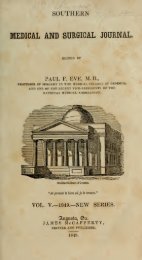Issue 10, pp. 753-832, October 1861, SMSJ
Issue 10, pp. 753-832, October 1861, SMSJ
Issue 10, pp. 753-832, October 1861, SMSJ
Create successful ePaper yourself
Turn your PDF publications into a flip-book with our unique Google optimized e-Paper software.
practical754 i;i'Ji J'oXes, on the Indigenous [<strong>October</strong>,Yellow Jessamine, (Gclseminum sempervirins.)— Accidental discoveryof its value in malarial fever ;use of in Western States ; testimonyof Drs. Cleveland, Nash, J. A, Mayes and others, to its medicinal propertiesand uses; dose and mode of administration.Milk Weed, or Root of Man, (Asclepias syriaca.)—Testimony ofDr. Richard S. Oauthorn, of Richmond, Va., to its value in intermittentfever.Common Salt, (Chloride of Sodium.)— Dr. Scclle Montdezert thefirst to call i he attention of the profession to the value of Chloride ofSodium in the treatment of intermittent fever ; testimony of Dr. W. P.Lattiinorc to the success of M. Piory with common salt in the treatmentof intermittent fever ;testimony of Drs. Moroschkin and Dr. Hutchinson;dose and mode of administration.Sal Ammqniac, (Ilydrochlorate of Ammonia.)—Testimony of Dr.Felix Jacquot to its value in intermittent fever.Nitric Acid.—Testimony of Drs. George Mendenhall, Bailey, J. C.Thompson, and Dr. William A. Hammond.Arsenic.—Testimony, experiments and investigations of Drs. FelixJacquot upon its relative value in the treatment of malarial fever ; testimonyof M. Boudin.Ligature oj r the Extremities in 1/an miiient Fever.—Testimonyof J. PeDrauw and others to the effects ciligature of the extremities inintermittent fever.Cold Water in tJteTreatment of Malarial Fever.— V^e of by Dr.Wright in 1786 : rules for its use, by Dr. J. Currie, of England; testimony of M. Fleury to the value of cold douches in the treatmentof intermittent fever.WILD IIOEEHOUND1 (EUPATOIUUM EOTUXDI-FOLIUM. Eli..Botanical Description.—Leaves sessile, distinct, deltoid, nearlyround, obtusely serrate, veined, somewhat glaucous; scales of the involucrumacute, Stem two to three feet high, very pubescent. Leaveso<strong>pp</strong>osite, decussate, triplinerved, dotted, slightly scabrous, with a somewhatglaucous, or perhaps more correctly, hoary hue. Flowers in a fastigiatecorymb. Involucrum ten leaved, five flowered ; leaves lanceolate,acute, very pubescent. Corolla white. Stamens very short. Stylemuch longer than the Corolla. Seeds angled, Pa<strong>pp</strong>us scabrous, longerthan the corolla. Decoctions of this, as well as of the preceding species,used with much success as a tonic febrifuge. I have always suspectedthis plant te be the E, Marrbium of Walter. It is commonlyknown through our low country as the Wild Ilorehound, and its leavesbear more to the Garden Ilorehound, (inarrubiuin vulgare,) thanthose of an) -other of our species.Grows in dry pine barrens.Flower.- from .July to September. Elliott. Sketch cf Botany ofSouth Carolina and Georgia, vol. 2, p 300.








